
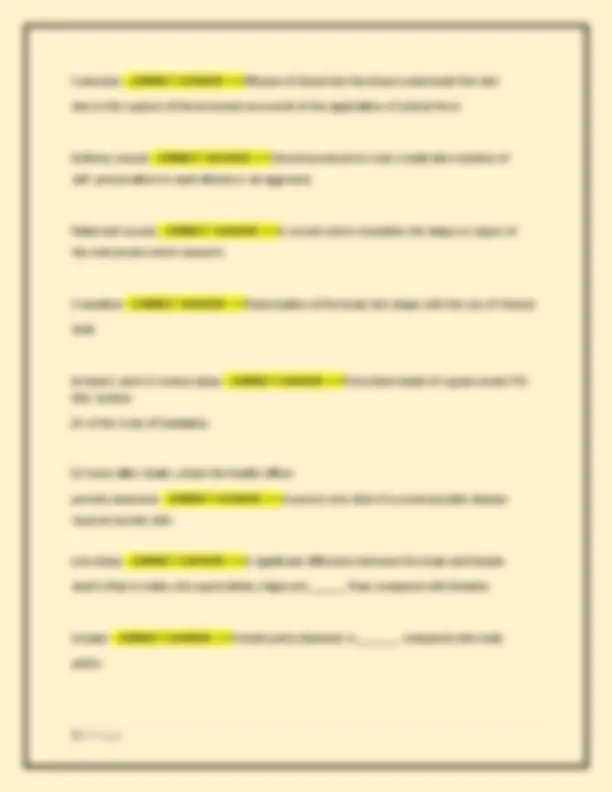
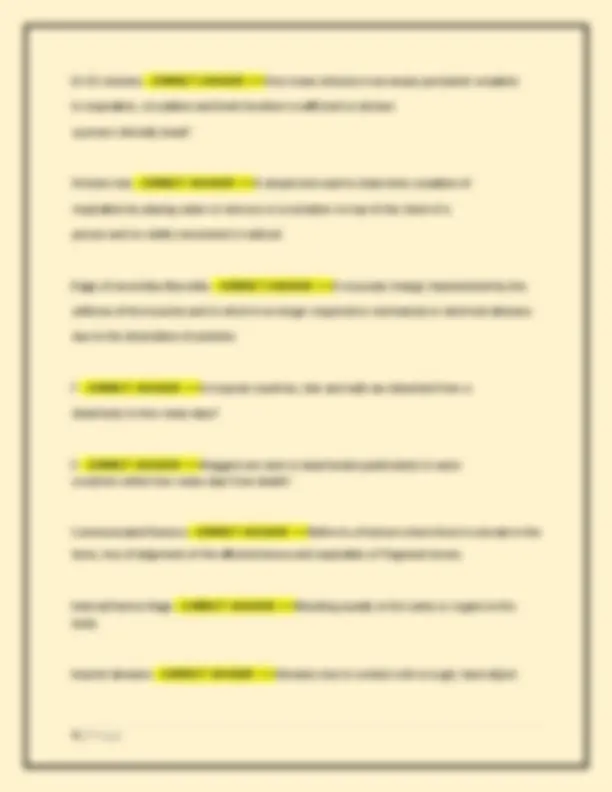
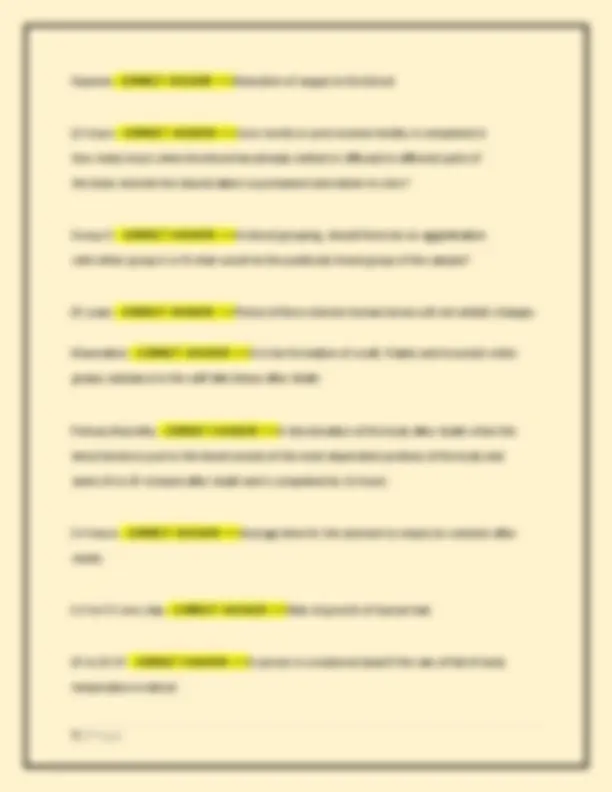
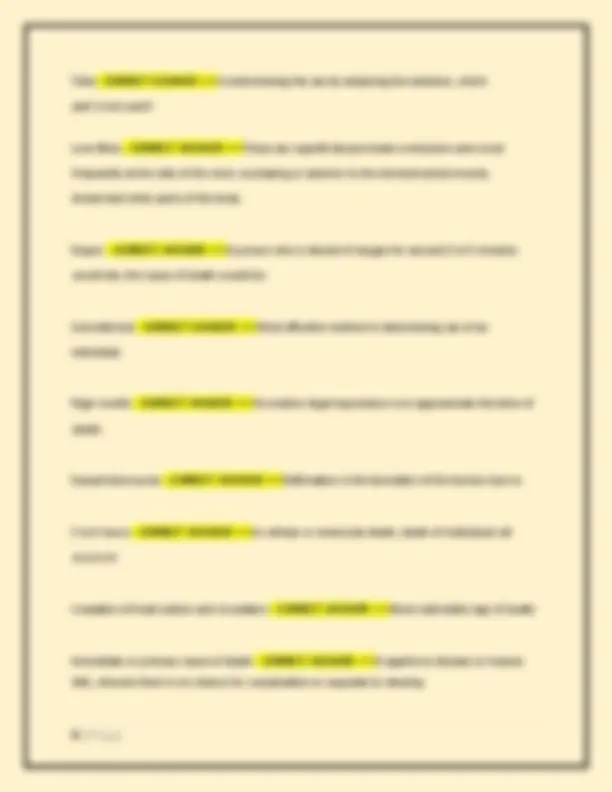
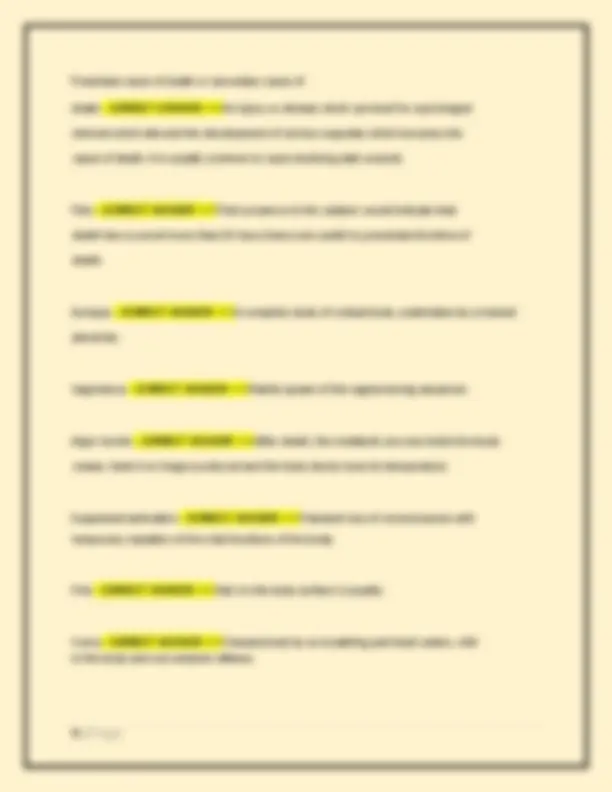
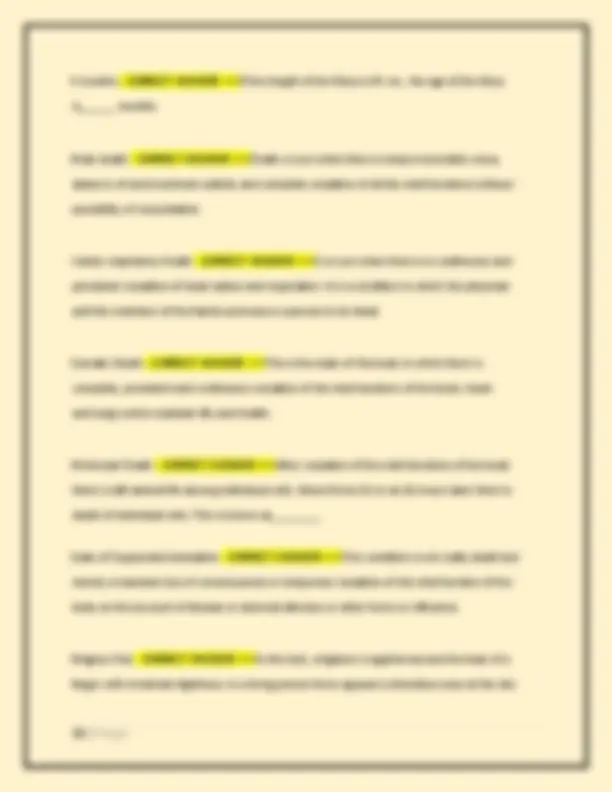
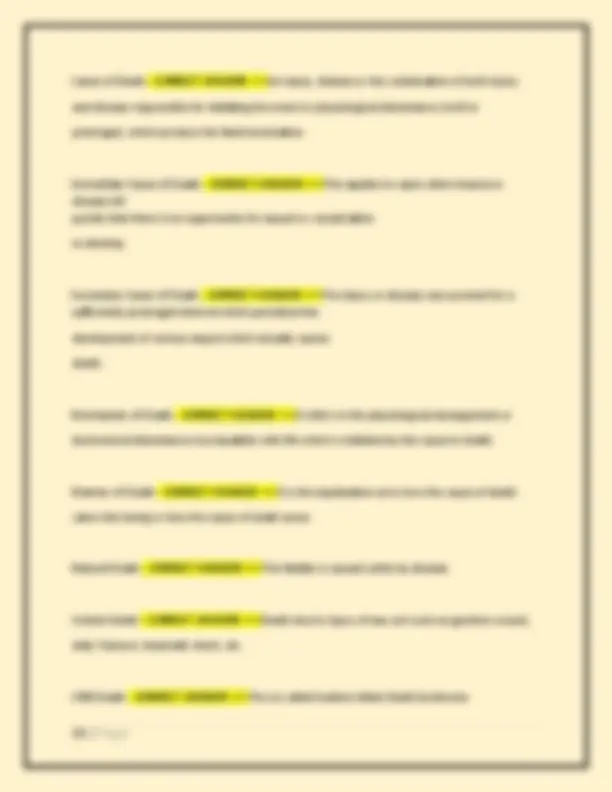



Study with the several resources on Docsity

Earn points by helping other students or get them with a premium plan


Prepare for your exams
Study with the several resources on Docsity

Earn points to download
Earn points by helping other students or get them with a premium plan
Community
Ask the community for help and clear up your study doubts
Discover the best universities in your country according to Docsity users
Free resources
Download our free guides on studying techniques, anxiety management strategies, and thesis advice from Docsity tutors
SPECIAL CRIME INVESTIGATION WITH LEGAL MEDICINE FINAL EXAM CONTAINS 100 QUESTIONS & CORRECT ANSWERS (WELL VERIFIED)
Typology: Exams
1 / 14

This page cannot be seen from the preview
Don't miss anything!









Imhotep - CORRECT ANSWER >>> Builder of the first pyramid, he was considered as the first or earliest recorded medico legal expert. Dr. Gregorio T. Lantin - CORRECT ANSWER >>> First chief medico legal officer of the Philippine Commonwelth. Paulus Zacchias - CORRECT ANSWER >>> Regarded as the Father of Forensic Medicine. Antistius - CORRECT ANSWER >>> Earliest known forensic pathologist or police surgeon, who performed the autopsy of Julius Caesar, reporting that out of the 23 stab wounds, only one penetrated the chest cavity between the first and second rib which was Caesar's proximate cause of death. Dr. Enrique V. delos Santos - CORRECT ANSWER >>> First chief of the Medico Legal Division of the Bureau of Investigation. Law of multiplicity of evidence in identification - CORRECT ANSWER >>> This states that the greater number of points of similarities and variations between two persons, the greater the probability of the conclusion to be accurate.
Reddish-brown - CORRECT ANSWER >>> Color of blood when exposed to the atmosphere. Arterial blood - CORRECT ANSWER >>> It has for its characteristics as, bright scarlet in color, with high oxygen content and leaves the blood vessel with pressure. Venous blood - CORRECT ANSWER >>> Dark red in color, with low oxygen content and usually does not spill far from the wound. Menstrual blood - CORRECT ANSWER >>> This blood contains a high number of deodorleins bacillus, it does not clot and has acidic reactions. Embolism - CORRECT ANSWER >>> A condition in which foreign matters are introduced in the blood stream blocking the blood circulation in the finer capillaries and arteries. Shock - CORRECT ANSWER >>> It is the disorder of the fluid balance due to peripheral deficiency, characterized by the decreased blood volume, its flow, hemo-concentration and renal deficiency. Hemorrhage - CORRECT ANSWER >>> Extravasations or loss of blood from the circulation due to inflicted wounds in the cardio-vascular system. Infection - CORRECT ANSWER >>> The growth and development of micro-organism in the location of the injury or wound.
10 - 15 minutes - CORRECT ANSWER >>> How many minutes is necessary persistent cessation in respiration, circulation and brain function is sufficient to declare a person clinically dead? Winslov test - CORRECT ANSWER >>> A simple test used to determine cessation of respiration by placing water or mercury in a container on top of the chest of a person and no visible movement is noticed. Stage of secondary flaccidity - CORRECT ANSWER >>> A muscular change characterized by the softness of the muscles and in which it no longer responds to mechanical or electrical stimulus due to the dissolution of proteins. 7 - CORRECT ANSWER >>> In tropical countries, hair and nails are detached from a dead body in how many days? 3 - CORRECT ANSWER >>> Maggots are seen in dead bodies particularly in warm countries within how many days from death? Communicated fracture - CORRECT ANSWER >>> Refers to a fracture where there is a break in the bone, loss of alignment of the affected bones and separation of fragment bones. Internal hemorrhage - CORRECT ANSWER >>> Bleeding usually in the cavity or organs in the body. Imprint abrasion - CORRECT ANSWER >>> Abrasion due to contact with a rough, hard object.
Hypoxia - CORRECT ANSWER >>> Reduction of oxygen in the blood. 12 hours - CORRECT ANSWER >>> Livor mortis or post mortem lividity is completed in how many hours when the blood has already clotted or diffused to different parts of the body wherein the discoloration is permanent and darker in color? Group O - CORRECT ANSWER >>> In blood grouping, should there be no agglutination with either group A or B what would be the particular blood group of the sample? 20 years - CORRECT ANSWER >>> Period of time wherein human bones will not exhibit changes. Maceration - CORRECT ANSWER >>> It is the formation of a soft, friable and brownish white greasy substance in the soft fatty tissue after death. Primary flaccidity - CORRECT ANSWER >>> A discoloration of the body after death when the blood tends to pool in the blood vessels of the most dependent portions of the body and starts 20 to 30 minutes after death and is completed by 12 hours. 3 - 4 hours - CORRECT ANSWER >>> Average time for the stomach to empty its contents after meals. 0.4 to 0.5 mm./day - CORRECT ANSWER >>> Rate of growth of human hair. 15 to 20 0F - CORRECT ANSWER >>> A person is considered dead if the rate of fall of body temperature is about:
Coup and contre coup injury - CORRECT ANSWER >>> A physical injury which is found at the site and also the opposite site of the application of force. Coup injury - CORRECT ANSWER >>> A physical injury found at the site of the application of force. Lacerated wound - CORRECT ANSWER >>> A wound produced by a blunt instrument such as log and stone. Punctured wound - CORRECT ANSWER >>> When the person was stabbed by an ice pick, what wound would be exhibited? Lacerated wound - CORRECT ANSWER >>> Wound produced by a butcher's knife. Virgo-intacta - CORRECT ANSWER >>> A condition of a woman who has had one or more sexual experience but not had conceived a child. Putrefaction - CORRECT ANSWER >>> Refers to the action of bacteria to a dead body. Frostbite - CORRECT ANSWER >>> A condition of exposure to cold temperature of certain parts of the body which produces mechanical disruption of cell structure characterized by cold stiffening and diminished body temperature. Heat exhaustion - CORRECT ANSWER >>> Failure of adequate heat elimination related to the breakdown of sweating mechanism.
Tibia - CORRECT ANSWER >>> In determining the sex by analyzing the skeleton, which part is not used? Love Bites - CORRECT ANSWER >>> These are superficial punctuate contusions seen most frequently at the side of the neck, overlaying or anterior to the sternomostoid muscle, breast and other parts of the body. Stupor - CORRECT ANSWER >>> A person who is devoid of oxygen for around 3 to 5 minutes would die, the cause of death would be: Gonodal test - CORRECT ANSWER >>> Most effective method in determining sex of an individual. Rigor mortis - CORRECT ANSWER >>> Its medico-legal importance is to approximate the time of death. Sexual intercourse - CORRECT ANSWER >>> Defloration is the laceration of the hymen due to: 3 to 6 hours - CORRECT ANSWER >>> In cellular or molecular death, death of individual cell occurs in: Cessation of heart action and circulation - CORRECT ANSWER >>> Most noticeable sign of death Immediate or primary cause of death - CORRECT ANSWER >>> It applies to disease or trauma kills, wherein there is no chance for complication or sequelae to develop.
9 months - CORRECT ANSWER >>> If the length of the fetus is 45 cm., the age of the fetus is______ months. Brain death - CORRECT ANSWER >>> Death occurs when there is deep irreversible coma, absence of electrical brain activity and complete cessation of all the vital functions without possibility of resuscitation. Cardio-respiratory Death - CORRECT ANSWER >>> It occurs when there is a continuous and persistent cessation of heart action and respiration. It is a condition in which the physician and the members of the family pronounce a person to be dead. Somatic Death - CORRECT ANSWER >>> This is the state of the body in which there is complete, persistent and continuous cessation of the vital functions of the brain, heart and lungs which maintain life and health. Molecular Death - CORRECT ANSWER >>> After cessation of the vital functions of the body there is still animal life among individual cells. About three (3) to six (6) hours later there is death of individual cells. This is known as________. State of Suspended Animation - CORRECT ANSWER >>> This condition is not really death but merely a transient loss of consciousness or temporary cessation of the vital function of the body on the account of disease or external stimulus or other forms or influence. Magnus Test - CORRECT ANSWER >>> In this test, a ligature is applied around the base of a finger with moderate tightness. In a living person there appears a bloodless zone at the site
of the application of the ligature. If such ligature is applied to the finger of a dead man, there is no such change in color. Algor-Mortis - CORRECT ANSWER >>> After death the metabolic process inside the body ceases. No more heat is produced but the body loses slowly its temperature, evaporation or by conduction to the surrounding atmosphere. The progressive fall of the body temperature is one of the most prominent signs of death. This is known as_______. Post-mortem Caloricity - CORRECT ANSWER >>> It is the rise of temperature of the body after death due to rapid and early putrefactive changes or some internal changes. Stage of Primary Flaccidity/Period of Muscular Irritability - CORRECT ANSWER >>> The muscles are relaxed and capable of contracting when stimulated. The pupils are dilated, the sphincters are relaxed, and there is incontinence of urination and defecation. Stage of Secondary Flaccidity/Secondary Relaxation - CORRECT ANSWER >>> The muscles become flaccid, and no longer capable of responding to mechanical and chemical stimulus and the reaction become alkaline. Stage of Post Mortem Rigidity or Cadaveric Rigidity or Rigor Mortis - CORRECT ANSWER >>> The whole body becomes rigid due to the contraction of the muscles. This develops three to six hours after death and may last from twenty-four to thirty-six hours.
Cause of Death - CORRECT ANSWER >>> An injury, disease or the combination of both injury and disease responsible for initiating the trend or physiological disturbance, brief or prolonged, which produce the fatal termination. Immediate Cause of Death - CORRECT ANSWER >>> This applies to cases when trauma or disease kill quickly that there is no opportunity for sequel or complication to develop. Secondary Cause of Death - CORRECT ANSWER >>> The injury or disease was survived for a sufficiently prolonged interval which permitted the development of serious sequel which actually causes death. Mechanism of Death - CORRECT ANSWER >>> It refers to the physiological derangement or biochemical disturbance incompatible with life which is initiated by the cause to death. Manner of Death - CORRECT ANSWER >>> It is the explanation as to how the cause of death came into being or how the cause of death arose. Natural Death - CORRECT ANSWER >>> The fatality is caused solely by disease. Violent Death - CORRECT ANSWER >>> Death due to injury of any sort such as gunshot wound, stab, fracture, traumatic shock, etc. CRIB Death - CORRECT ANSWER >>> The so-called Sudden Infant Death Syndrome.